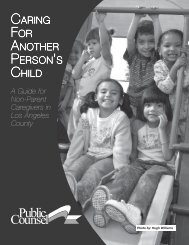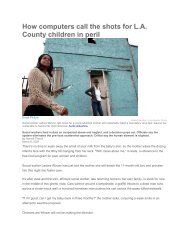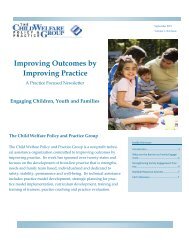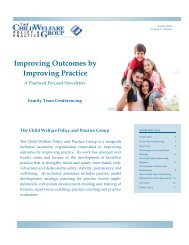DCFS News Summer Issue (PDF) - Los Angeles County Department ...
DCFS News Summer Issue (PDF) - Los Angeles County Department ...
DCFS News Summer Issue (PDF) - Los Angeles County Department ...
You also want an ePaper? Increase the reach of your titles
YUMPU automatically turns print PDFs into web optimized ePapers that Google loves.
D C F S NEWS<br />
MESSAGE FROM THE DIRECTOR<br />
Overcoming Obstacles,<br />
Building a New Culture<br />
Your commitment to servicing families in order to keep<br />
them safely together is evident in the steady increase<br />
in the number of Family Reunification cases over the past<br />
year. The department has seen Family Reunification cases<br />
rise from 8,048 in April 2004 to 8,427 in March 2005. We<br />
have also seen our Permanent Placement caseload drop, from<br />
17,731 in April 2004 to 16,104 in March 2005, as we close<br />
more of these cases by finding permanent homes for children<br />
in foster care. These numbers are a great start as we continue<br />
to challenge some of the internal and external roadblocks to<br />
permanency.<br />
As we move toward increased permanency for children in<br />
foster care, we must continue to change our organizational<br />
culture. An assessment of the Achieving Permanency Workgroup<br />
suggested that we need to continue to emphasize the<br />
importance of legal permanency for all children in foster care.<br />
While we have made significant changes, it still takes too long<br />
for a child to be returned home. It still takes too long for a<br />
child to be adopted. We still emancipate too many youth<br />
from foster care every month. Long-held internal and external<br />
biases against adoption and legal guardianship, as well as<br />
the belief that long-term foster care is a suitable permanent<br />
plan, are challenges that need to be addressed before we can<br />
move forward.<br />
We plan on strengthening training to staff in the areas of<br />
legal permanency and have developed new technology tools<br />
to ease the burden of paperwork and make the Concurrent<br />
Planning process easier for all levels of staff.<br />
The assessment also indicated that a “PP (Permanent Placement)<br />
mentality,” or the thought that children can be stable<br />
without a legally permanent family or connection, still exists. I<br />
am aware that staff feels there are disincentives for closing<br />
“easy” cases and that there is a pervasive fear that you will be<br />
“rewarded” with more, often harder cases.<br />
I also know that the amount of time staff needed to focus<br />
on permanency plans can be daunting. Even in these tight<br />
budget times, the department is committed to providing<br />
additional staff for Team Decision-Making and will hire<br />
additional employees to fill behind staff who are on extended<br />
medical leaves.<br />
In the coming months, I will look to the offices to come up<br />
with the innovative permanency ideas that work best for you.<br />
The freedom to focus on these office-specific permanency<br />
objectives should result in more children reunifying with their<br />
families and less youth emancipating from foster care with no<br />
legally permanent plan or significant adult in their lives.<br />
David Sanders, Ph.D.<br />
Director<br />
Inside This <strong>Issue</strong>:<br />
2 Success Stories<br />
3 New Deputy Director<br />
4 BIS Tools<br />
Continued on Page 3<br />
5<br />
7<br />
8 Employees of the Month<br />
Information for Employees of the <strong>Los</strong> <strong>Angeles</strong> <strong>County</strong> <strong>Department</strong> of Children and Family Services<br />
<strong>Summer</strong> 2005<br />
On the Line<br />
Victims of Crime Unit<br />
Offices Create Customized<br />
Permanency Plans<br />
Workgroup Identifies Barriers, Solutions<br />
During the past year, <strong>Los</strong> <strong>Angeles</strong> <strong>County</strong> <strong>Department</strong> of Children<br />
and Family Services (<strong>DCFS</strong>) managers and staff recognized there is<br />
no singular answer to the issue of finding permanent homes for<br />
children and that multiple solutions are needed to increase legal permanency<br />
of older foster youth, especially those over 12 years old.<br />
“We started looking at the best ways to achieve legal permanency for the<br />
nearly 14,000 kids who have been in care for two years or longer – with over<br />
half of them being age 12 years or older,” said Deputy Director Trish Ploehn.<br />
Ploehn was charged with setting up an “Achieving Permanency<br />
Workgroup” to develop long and short-term plans and strategies for<br />
increasing the percentage of foster youth who exit the system with a legally<br />
permanent plan and strong ties to one or more nurturing adults. One goal of<br />
the workgroup, said Ploehn, was to be realistic about the barriers and<br />
challenges staff would face, and find solutions to those barriers. Some of the<br />
barriers discussed included the reluctance from relatives to adopt, the loss of<br />
financial assistance for establishing guardianship for special needs youth, the<br />
need for more Independent Living Services and the need to consolidate<br />
permanency resources.<br />
After a series of meetings with department staff and managers, a draft plan<br />
was developed in May. With the assistance of the Bureau of Information<br />
Services, regional offices were given the names of youth on their caseloads<br />
who have been in care for two years or longer so each office could target<br />
specific children with a plan. The offices are now assigned with creating their<br />
own customized permanency plans.<br />
“We asked each office to pick a focus,” said Ploehn. “Some might choose<br />
to start their work with younger children, some might want to focus on older<br />
youth or youth in group homes. Others might want to concentrate on legal<br />
permanency for children in relative care.”<br />
The workgroup found that some <strong>DCFS</strong> offices have already developed<br />
numerous strategies. In the Torrance office, through an idea initiated by<br />
staff, Regional Administrator Harvey Kawasaki has created a new<br />
permanency unit called LEAPS (Life-skills, Emancipation Aimed at<br />
Permanency and Self-Sufficiency). The unit’s goal is to provide<br />
comprehensive permanency services and resources to a specific population<br />
(children 16 years and older), with a focus on exploring and initiating<br />
alternate legal permanency options including adoption, legal guardianship<br />
and mentors.<br />
Recently, <strong>DCFS</strong> applied for and was selected to receive a state Youth<br />
Permanency Task Force grant. As part of this grant, the Metro North office<br />
will receive technical assistance to improve permanency for youth living in<br />
group homes. The office has already begun working with Five Acres,<br />
Sycamores and Vista del Mar group homes.<br />
To further assist with office permanency plans, the department is<br />
expanding the Permanency Partners Program (P3) and has hired retired<br />
social workers for each of the offices. As part of the expansion of P3, the<br />
department is publishing a “Youth Permanency Handbook” for all staff.<br />
1
2<br />
<strong>DCFS</strong> Success Stories<br />
As a regular part of "<strong>DCFS</strong> <strong>News</strong>," we recognize the successes of the <strong>Los</strong> <strong>Angeles</strong> <strong>County</strong> <strong>Department</strong> of Children and Family<br />
Services (<strong>DCFS</strong>) and its community partners. These success stories are diverse and offer an opportunity for staff and community<br />
partners to celebrate accomplishments and share the good work they are doing. To submit story ideas for this section, please e-mail Stuart<br />
Riskin of the <strong>DCFS</strong> Office of Public Affairs at riskis@dcfs.co.la.ca.us.<br />
In this edition of “<strong>DCFS</strong> <strong>News</strong>” Success Stories we highlight the youth honored during the 2005 <strong>Los</strong> <strong>Angeles</strong> Foster Care Awareness Campaign<br />
held in May. These youth exemplify some of the best of our foster care system – whether through working for systemic reform, achieving artistic goals,<br />
advocating on behalf of foster children, providing direct assistance to youth in need, or preserving and attaining success even in the face of difficult odds.<br />
Pedro Martinez, 18<br />
Winner of the Foster Care Awareness<br />
Campaign Art Project<br />
Pedro created this winning self-portrait with the guidance of renowned<br />
artist Judy Baca. As part of his award, he received a series of art classes<br />
from the Barnsdall Art Park in Hollywood.<br />
Tramisha Poindexter-2005 Foster Care Hero Youth Honoree<br />
It’s a<br />
long journey<br />
from a<br />
group home<br />
in Compton<br />
to the halls<br />
of the<br />
U n i t e d<br />
Nations in<br />
Geneva, Switzerland, but former foster youth<br />
Tramisha Poindexter is determined to make the<br />
most of every opportunity to speak out for the<br />
needs of children in our foster care system.<br />
When Tramisha entered foster care as a<br />
young child after her mother died, she lacked a<br />
good support system and dealt with loneliness,<br />
fear, and sadness while trying to find stability<br />
and build a foundation for her adult life.<br />
This year, Tramisha was named as one of<br />
eight <strong>Los</strong> <strong>Angeles</strong> <strong>County</strong> “Foster Care Heroes”<br />
during the annual celebration of Foster Care<br />
Awareness Month in May. Tramisha was<br />
honored because she exemplifies the great<br />
personal resilience of foster youth and, after<br />
stabilizing her own life and establishing her own<br />
adult path, dedicated herself to improving the<br />
Chelsea Clemons, 16<br />
Winner of the Foster Care Awareness<br />
Campaign Writing Project<br />
“Questions for My Mother”<br />
What’s it like to wake up in an ice-cream truck?<br />
What’s it like to wake up alone?<br />
How do you feel when your children don’t call you?<br />
How does it feel to know you’ll never be the same?<br />
What keeps you coming to court when you know you’ll never<br />
get us back?<br />
How was your childhood ?<br />
Did you have any friends? Did you ever smile?<br />
How much do you cry?<br />
Do you ever laugh?<br />
How hard is it to say good-bye to everything?<br />
Do you have any hope?<br />
Do you have any pride?<br />
Why did you give us up?<br />
Do you regret it?<br />
Do you ever think you’ll be normal again?<br />
Why do you act so immature?<br />
When will you take responsibility for your actions and take charge<br />
of your life?<br />
When will you stop making people feel sorry for you?<br />
What’s it like to wake up in an ice-cream truck?<br />
As part of her award, Chelsea received a laptop computer and printer<br />
and had her work published in a Campaign booklet. She worked on<br />
the poem above with the guidance of children’s book author Kerry<br />
Madden.<br />
lives of others.<br />
A leader of California Youth Connection, a<br />
grass roots organization advocating for foster<br />
youth, Tramisha has traveled widely to help<br />
develop skills of transitioning foster youth and<br />
advocate for legislation to improve the foster<br />
care system. Tramisha is also a poet; her work<br />
reflects her own beauty, strength, and unique<br />
personality and makes a powerful impact on<br />
everyone she meets. In Tramisha’s own words,<br />
"Situations sometimes come with no invitation<br />
and leave with no explanation. It’s up to us to<br />
reach our final destination!"
Customized Permancy Plans<br />
Continued from Page 1<br />
The handbook will include success stories, an<br />
explanation of permanency funding streams and practical<br />
tips and information on how to move children into<br />
permanency. Later this year, a department-wide training<br />
will focus on the permanency of older youth.<br />
In addition, <strong>DCFS</strong> will soon be embarking on a joint<br />
workgroup with the Children’s Court on how <strong>DCFS</strong> and<br />
our legal partners can better work together to effect timely<br />
legal permanency for all children served by our respective<br />
systems.<br />
<strong>DCFS</strong> is also looking at legislative changes to address<br />
and eliminate the financial disincentives for youth leaving<br />
foster care and entering into a legally permanent plan.<br />
Each office is now working on written permanency plans<br />
to submit to the <strong>DCFS</strong> Executive Team. The plans will<br />
include the target population, specific strategies to be used<br />
by the office, specific timeframes and measurable goals for<br />
permanency.<br />
“We are beginning a cultural shift,” said Director Dr.<br />
David Sanders. “We need staff to start embracing the<br />
concept that legal permanency for foster children is<br />
achievable and that it is urgent.”<br />
Achieving Permanency<br />
<strong>Department</strong> Responsibilities<br />
Training including in-service training on adoptions for social<br />
workers and seminars on the importance for permanency.<br />
Public messages to create support among community partners<br />
and agencies that serve clients.<br />
Permanency partnerships will be enhanced and expanded to<br />
support the new directions of legal permanency for all children.<br />
Support legislative change to address disincentives at the<br />
state and federal levels.<br />
Provide office support including additional staff to help with<br />
Team Decision-Making, expanding P3 staff and maintaining office<br />
staff levels as caseloads decrease.<br />
Office Responsibilities<br />
Choose a target population of youth.<br />
Identify current programs and resources available to assist offices.<br />
Select strategies.<br />
Provide a written plan.<br />
Lisa Parrish Named New<br />
Deputy Director of<br />
Resources Bureau<br />
New Bureau Committed to<br />
Supporting Families in Crisis<br />
In March, Elisa (Lisa)<br />
Parrish joined the <strong>Los</strong><br />
<strong>Angeles</strong> <strong>County</strong> <strong>Department</strong><br />
of Children and Family Services<br />
(<strong>DCFS</strong>) as the Deputy Director for<br />
the department’s newly created<br />
Bureau of Resources. The new<br />
bureau will contain several divisions<br />
including Emancipation Services,<br />
Out-of-Home Care/Quality Assurance,<br />
Community-Based Support, Multi-Agency<br />
Services and Kinship/ASFA. The Bureau of<br />
Resources was created to bring together<br />
programs <strong>DCFS</strong> contracts with private providers.<br />
“The goal of the bureau is to reinvest money for<br />
community-centered, family-based services which in<br />
turn will support families in crisis, therefore helping<br />
them to become the best families they can be,” said<br />
Parrish. Parrish is most excited about “creating a<br />
kinship support unit to do a more dynamic job of<br />
supporting relatives.” Another exciting aspect of the<br />
new bureau will be the planned expansion of Wraparound<br />
Services.<br />
For six years prior to joining <strong>DCFS</strong>, Parrish was the<br />
Deputy Commissioner for Foster Care and Preventive<br />
Services for the City of New York’s Administration for<br />
Children’s Services. As Deputy Commissioner, Parrish<br />
reduced the number of children in out-of-home care<br />
by 46 percent and increased the amount of children<br />
remaining in their homes by 18 percent through the<br />
provision for community-based services.<br />
Prevention and front-end, home-based services is at<br />
the forefront of Parrish’s mandate for the new Bureau<br />
of Resources as part of the department’s commitment<br />
to the Katie A. panel.<br />
Lisa Parrish<br />
3
4<br />
New BIS Tools<br />
I<br />
t’s 8 a.m. You’ve just arrived at your office and switched on your computer. You try to open Outlook to check<br />
After banging your mouse and grumbling a few choice words at the computer screen, you pick up the phone<br />
hope your problem is addressed within a couple of hours. Sound familiar?<br />
New Technology Tools<br />
Streamline Paperwork and<br />
Provide Faster, Easier Help<br />
What if you could save some of the aggravation by shortening<br />
the time it takes to get help? Several new tools<br />
recently initiated by the Bureau of Information Services<br />
(BIS) are designed to provide faster, easier service and<br />
create a more mobile, paperless workforce.<br />
“A lot of people get frustrated when they have computer<br />
problems and just want them corrected quickly,” said BIS<br />
Deputy Director Leo Yu. “We understand the frustration and<br />
we’re here to help you. Through these new tools we hope<br />
to help staff work more efficiently and make it easier to<br />
provide safety and permanency for youth and families. It’s<br />
also important that we move in this direction because we<br />
are increasingly becoming a more mobile and paperless<br />
workforce.”<br />
All of the following new <strong>DCFS</strong> technology tools are<br />
centered around social work and designed to assist social<br />
workers and staff. These tools will also work to streamline<br />
some of the endless paperwork involved in social work. By<br />
using these tools, staff will have more time to spend helping<br />
children and families.<br />
“<br />
One of the pluses of the new IT Service<br />
Request System is the automatic tracking tool.<br />
The new system is great and much easier<br />
because it automatically tracks your requests<br />
so you can view the progress at any point<br />
along the way.<br />
”<br />
-Mary Elshehawy, Staff Assistant<br />
Santa Fe Springs Office<br />
Concurrent Planning Redesign<br />
Pilot Site<br />
This new internal web site has been developed as a joint<br />
Labor-Management initiative to address the goal of<br />
returning a child that has entered foster care into a safe,<br />
stable, and lifelong home. In working towards this goal, the<br />
Concurrent Planning Re-Design Pilot is being implemented<br />
in five <strong>DCFS</strong> offices that serve approximately one third of<br />
the children in out-of-home care. The Concurrent Planning<br />
Redesign Pilot web site provides you with answers to<br />
frequently asked questions, documents designed to assist<br />
with implementation of pilot protocols, status updates and<br />
people you can contact for assistance. The web site can be<br />
accessed through L.A. Kids.<br />
CWS/CMS on the Web<br />
Web access to CWS/CMS will allow staff to access this vital<br />
system from anywhere, 24 hours a day, by using the web.<br />
Staff will be able to connect to CWS/CMS anywhere they<br />
can connect to the internet. BIS is also looking at providing<br />
outstation access to e-mail and L.A. Kids.<br />
“<br />
The ‘ticklers’ included in the new IT Service<br />
Request System reminds me to follow through so<br />
requests will never be lost.<br />
MyCSW<br />
”<br />
-Kathleen Kurkjian, Senior Secretary<br />
Emancipation Services Division<br />
MyCSW, developed with and for social workers, is an<br />
online workspace and information portal for social workers<br />
that organizes and streamlines the activities central to case<br />
management. The goal of MyCSW is to reduce the burden<br />
of office tasks so that social workers can focus more on<br />
personal interaction with children and families.<br />
MyCSW provides each social worker a personalized home<br />
page containing critical information needed by the worker<br />
to meet case goals. The information includes tracking case<br />
milestones and monitoring CWS/CMS alerts. MyCSW also<br />
allows workers to organize their day-to-day case activities,<br />
which includes viewing their caseload geographically,<br />
accessing caseload-related reports and viewing child history<br />
abstracts. The abstracts include past referrals, associated<br />
cases, foster care placements and payments. There are also<br />
alerts for important upcoming and overdue activities such<br />
as participating in forum discussions and locating resource<br />
information geographically.<br />
The first phase of implementation, dedicated to<br />
case-carrying social workers, began in March. The MyCSW<br />
for Emergency Response social workers was implemented<br />
in June. This time-management automation program frees<br />
up more time for social workers to focus on protecting<br />
children and supporting their families. A MySCSW<br />
personalized home page is also in development.<br />
IT Service Request System<br />
Want to move your computer? Need a new printer or<br />
monitor? This new system automates the IT Service<br />
Request process so that users can initiate and track the<br />
progress of any request made. Approvals of the requests<br />
can be made on the computer, eliminating the hard copy<br />
signature and speeding up the process.
your e-mail, but can’t get in.<br />
the phone and call the Help Desk and<br />
IT Service Desk<br />
Next time you have a computer problem,<br />
there’s no need to pick up the phone.<br />
Launched in July, the new IT Service<br />
Desk provides an easily accessible, faster<br />
system to provide tech help via the web.<br />
Now, the easiest and fastest way to get<br />
IT support and help is by logging onto<br />
the new IT Service Desk web site at<br />
http://infrasrv/itservicedesk. Through the<br />
site, the user can enter a computer problem<br />
and the new IT Service Desk<br />
software will send an e-mail to a CAT’s<br />
Blackberry. The CAT will be notified of<br />
your need for assistance and the<br />
response time for help will be decreased.<br />
If going online is not possible, you can<br />
call IT Service Desk at (562) 345-6789,<br />
from 7 a.m. to 6 p.m., Monday through<br />
Friday. You no longer have to call outside<br />
of <strong>DCFS</strong> to the Internal Services Division.<br />
The IT Service Desk is now in-house and<br />
located in the BIS’ Norwalk office. A<br />
dedicated team of highly skilled <strong>DCFS</strong><br />
CATs and customer support professionals<br />
will take calls.<br />
On-line Requests for<br />
Shelter Care<br />
Transportation<br />
<br />
As part of the newly developed Shelter<br />
Care web system, a new module was<br />
developed to provide regional social<br />
workers and clerical staff the ability to<br />
enter on-line requests for Shelter Care<br />
Transportation to and from the Children’s<br />
Court when children are required to<br />
appear in court. Use of this new system<br />
for requesting transportation eliminates<br />
the need to complete and fax hard copy<br />
transportation requests to the Shelter<br />
Care Unit. This module can be accessed<br />
through L.A. Kids - no user id or password<br />
is required to access this module.<br />
The new system will minimize data entry<br />
by populating the Transportation<br />
Request screen with CWS/CMS child and<br />
provider information. Acknowledgement<br />
of on-line requests will be displayed on<br />
the search result grid on the search<br />
screen.<br />
ON THE LINE<br />
“<br />
On the Line” is a “<strong>DCFS</strong> <strong>News</strong>” column<br />
featuring <strong>Los</strong> <strong>Angeles</strong> <strong>County</strong> <strong>Department</strong> of<br />
Children and Family Services’ social workers<br />
whose achievements and practice epitomize the best in social work.<br />
ILP Coordinator Helps Youth<br />
Take Charge of Their Lives<br />
I<br />
Maurissa Sanders<br />
ndependent Living Program (ILP) Coordinator Maurissa Sanders<br />
believes that Emancipation Division Chief Rhelda Shabazz<br />
recommended her for an “On The Line” profile because, “I tend to be<br />
outspoken and a go-getter. I try really hard to make sure that the services we<br />
provide benefit the kids.”<br />
“She is committed, capable and confident, ” noted Shabazz. “Her tireless efforts<br />
and resource development are a great benefit to transition age youth, especially those<br />
in South <strong>Los</strong> <strong>Angeles</strong>.”<br />
Sanders began her career with the department more than 12 years ago as a<br />
Children’s Social Worker trainee in a Family Maintenance/Reunification unit where<br />
she served for five years. She then moved on to the Training Section as an Emancipation<br />
Services Trainer. Sanders trained social workers and foster care providers on<br />
how to help youth who are over 14 years old and then joined the ILP program where<br />
she said, “I get to work with teens and encourage them to be the best they can be. My<br />
rewards are when the kids achieve and are stable.”<br />
Sanders dynamically describes an ILP Coordinator’s job as teaching and assisting<br />
youth to take charge of their lives by being a guidance counselor for foster youth on<br />
day-to-day issues.<br />
These social workers assist youth who are in out-of-home care or with<br />
non-related legal guardians to successfully exit the foster care system. The youth<br />
they deal with usually range in age from 16 years old to almost 21 years old.<br />
Initially, ILP Coordinators help make referrals for the youth to appropriate Life<br />
Skills Classes such as G.L.A.S.S.’s Stonewall program for Gay, Bisexual, Lesbian<br />
and Transgender youth, or the L.A. Conservation Corporation for youth who are not<br />
on a college-bound track.<br />
There are multiple issues that ILP Coordinators address with their youth,<br />
explained Sanders. Among them are education issues such as researching and<br />
applying for scholarships, paying tuition and purchasing books. Housing is another<br />
important issue for the youth with issues ranging from moving into Transitional<br />
Housing, to applying for financial assistance, to find their first apartment.<br />
Employment situations are also addressed such as dealing with work-related<br />
conflicts, transportation, purchasing work-required tools, attaining and purchasing<br />
uniforms and paying union dues. Sanders said there is financial assistance available<br />
for all of these needs. Assistance with driver’s training and car insurance are also<br />
available and funds do not have to be paid back to the department unless they are<br />
not used.<br />
Sanders is passionate about the work she does. Some of it comes from her<br />
personal experience.<br />
“Given my history of a chaotic family, I was lucky not to end up in the system,”<br />
she said. As a result of her early life, she can relate to her clients, especially teens.<br />
Stability is something that is very important to Sanders and she translates this<br />
message to her clients. She said she does see some youth thrive in spite of their<br />
tumultuous history.<br />
In recent years, Sanders helped a youth named “Brandy” who was raised by her<br />
maternal grandmother. Brandy traveled to Japan twice supported by ILP. She then<br />
went on to attend Spelman College where she studied international business with a<br />
focus on Japan. Today, she works for the city of Pasadena and is planning to attend<br />
law school.<br />
“She would have succeeded regardless,” Sanders humbly admitted. “She had it in<br />
her.”<br />
For more information on the Independent Living Program and the services it<br />
provides, call (213) 351-0111.<br />
5
6<br />
SPA SPOTS<br />
Sharette Garcia<br />
In every issue, "<strong>DCFS</strong> <strong>News</strong>"<br />
provides information about what's<br />
happening in the <strong>Los</strong> <strong>Angeles</strong> <strong>County</strong><br />
<strong>Department</strong> of Children and Family<br />
Services' (<strong>DCFS</strong>) Service Planning<br />
Areas (SPAs). If you have SPA news<br />
to report, please submit your ideas to<br />
Stuart Riskin of the <strong>DCFS</strong> Public<br />
Affairs Office at<br />
riskis@dcfs.co.la.ca.us.<br />
Concurrent Planning Redesign Update<br />
To improve permanency outcomes for children, <strong>DCFS</strong> has embarked on a comprehensive<br />
redesign of its service delivery system and Concurrent Planning process.<br />
Through the redesign, the Concurrent Planning system is being transformed into a<br />
“seamless delivery system,” said project head Nancy Chess. The key is getting parents<br />
on-board from their initial point-of-engagement with the department and keeping them<br />
involved throughout their cases including repeated full disclosure regarding the status of<br />
their case. Also, standardizing information collection and realigning job duties are being<br />
implemented to avoid redundancy and duplication of social worker’s efforts. “Teaming”<br />
between the divisions and workers involved on a case are key to making the redesign<br />
work, said Chess.<br />
Presently, Concurrent Planning is being piloted in five <strong>DCFS</strong> offices including Lakewood,<br />
Belvedere, Covina, Compton and North Hollywood. The redesign is under the<br />
auspices of a joint labor/management group, which includes <strong>DCFS</strong> Labor Relations head<br />
Priscilla Cruz and Locals 550 and 660 are full partners in the redesign.<br />
Under the direction of the Bureau of Information Systems, a new Automated Tracking<br />
System launched in July works off of CWS/CMS and replaces the old stand-alone<br />
system.<br />
Pregnant Teen Survey Underway<br />
A Teen Pregnancy Survey was implemented at the request of the <strong>DCFS</strong> Pregnant and<br />
Parenting Teen Workgroup, a collaboration between the department and the <strong>Los</strong> <strong>Angeles</strong><br />
Children's Law Center, The Alliance for Children's Rights and other external stakeholders.<br />
The project has been gathering data on the <strong>DCFS</strong> pregnant and parenting teen population<br />
including the number of minor mothers and the number of pregnant <strong>DCFS</strong>supervised<br />
youth. A data analysis is planned to determine what other information the<br />
department can cull from the survey. An analysis of the survey is expected later this<br />
fall.<br />
Team <strong>DCFS</strong> and the XX L.A. Marathon<br />
Team <strong>DCFS</strong> does it again! Through participation in the XX <strong>Los</strong> <strong>Angeles</strong> Marathon, the<br />
department raised $3,700 for the Families and Children’s Services Trust Fund. A huge<br />
congratulations to all the participating Team <strong>DCFS</strong> runners, walkers and bikers along<br />
with the committed volunteers who worked the team’s support station throughout the day.<br />
The weather gods were looking over the runners this year. The temperature that day<br />
was in the high 60s accompanied by a refreshing breeze instead of last year’s oppressive<br />
92 degrees. The volunteers were busy handing out water, orange slices and candy, while<br />
serving up a good dose of cheers and words of encouragement as runners passed the<br />
station.<br />
Veteran marathoner Shirley Logan was a lady on a mission. Although she was focusing<br />
on the finish line, Shirley took a slight detour to the water station while never breaking<br />
stride. Otto Astorga swung in for a pit stop. Volunteers jumped into action refueling<br />
Otto and getting him back on the track in record time. Armand Montiel shot by the<br />
station trying to beat his 2004 time. Our volunteers glimpsed other Team <strong>DCFS</strong> runners<br />
as they pushed on to cover the last 6 miles of the course.<br />
Lakewood Social Worker Returns from Iraq<br />
Lakewood Emergency Response Worker Sharette Garcia came to the United States 14<br />
years ago from Belize. She started working for the department and became a Family<br />
Maintenance and Reunification worker eight years ago. In 2001, Garcia received her<br />
Green Card and at that point she made a drastic decision.<br />
“I wanted to give back to this country all it had given to me,” said Garcia. So, with a<br />
supportive husband and two children at home, Garcia took a leave of absence from the<br />
department and joined the United States Armed Forces for a three-year hitch.<br />
Initially, Garcia explained that she wanted to experience being in the army and see if<br />
she could make it through basic training. Garcia never dreamed that she would be going<br />
off to war where she ended up as a Chemical Operations Specialist (COS) in Operation<br />
Iraqi Freedom.<br />
Garcia believes that her experiences as an Emergency Response Worker prepared her.<br />
As a COS, Garcia and her unit refueled transports, recycled fuel and drove it to the front.<br />
Her job also included setting up traffic checkpoints, driving tanks, and serving as a Tank<br />
Continued on Page 7
Spa Spots<br />
Continued from Page 6<br />
Commander, operating the tank’s guns. As a Fuel Specialist,<br />
Garcia and her unit frequently came under fire. Luckily, there<br />
were no casualties in her battalion.<br />
She completed her tour of duty and returned to the states in<br />
February 2004. A year later, she completed her obligation to the<br />
service. She then returned to her previous position at <strong>DCFS</strong> after<br />
having a baby. Garcia will now be a sergeant in the inactive<br />
reserves for the next eight years. She knows that she can still be<br />
called up for duty and shipped back to Iraq at any time.<br />
Garcia feels that her experience was all worth it. “You never<br />
know how much you appreciate something until you experience<br />
something different like dodging mortars.”<br />
Correction<br />
In the spring edition of “<strong>DCFS</strong> <strong>News</strong>”<br />
article on Specialized Programs’ Indian<br />
Child Welfare Unit, the court proceedings<br />
department was misidentified as <strong>Department</strong><br />
402. The correct <strong>Department</strong> is 413. In<br />
addition, if children and families are any<br />
part Native American, the court must make<br />
active efforts not reasonable efforts to<br />
notify the family’s tribe-of-origin.<br />
Programs Available to Aid<br />
Victims of Crime<br />
The he Victims of Crime (VOC) Program is one of the<br />
many resources available to <strong>Los</strong> <strong>Angeles</strong> <strong>County</strong><br />
<strong>Department</strong> of Children and Family Services (<strong>DCFS</strong>)<br />
minors who are dependents of the court through the Community<br />
Support Division.<br />
VOC provides crime victims with reimbursement for specified<br />
expenses directly related to a crime that are not reimbursed by<br />
other resources, explained Otho Day, manager of the program.<br />
Funds for the program come directly from fines imposed by both<br />
the state and federal courts on individuals who have committed<br />
crimes. Because the program works in conjunction with the<br />
District Attorney’s Office, it is essential that victims and their<br />
families cooperate with law enforcement throughout the investiinvestigation and prosecution of the crime, said Day.<br />
Who qualifies?<br />
<strong>DCFS</strong> youth eligible for VOC services must be 18 years old or<br />
under when the crime occurred. Siblings or relatives of victims<br />
under 18 years of age who were living in the same household at<br />
the time of the crime are also eligible for services. Clients who<br />
use VOC are mostly victims of child endangerment through<br />
domestic violence, victims of domestic violence itself, physical<br />
abuse and sexual abuse. Approximately 1,700 <strong>DCFS</strong> clients per<br />
year are referred to the program for help, Day said.<br />
What is reimbursable?<br />
Reimbursable expenses from the program include medical<br />
care, mental health counseling, special schooling,<br />
physical/occupational therapy, glasses and dental expenses.<br />
Day said the majority of the claims are for mental health<br />
reimbursement. VOC also covers expenses for adult victims<br />
including lost income if the victim is disabled as a result of the<br />
crime and job retraining due to a crime-related injury. Other<br />
expenses covered include home and vehicle modifications for<br />
the victim and home security if law enforcement feels that the<br />
family is in danger do to terrorist acts by the perpetrator(s).<br />
Insurance co-payments will also be requested on the VOC appliapplication if parents or caretaker cannot pay the co-payment or<br />
need to be reimbursed. The families of victims are also entitled<br />
to funeral expenses for the victim up to $5,000. However, if the<br />
victim was a <strong>DCFS</strong> dependent, the family needs to apply through<br />
the SCIAP program.<br />
A family is also entitled to lost support if a loved one is killed<br />
or disabled by the crime. They can also be reimbursed for the<br />
crime scene cleanup when the crime occurs in someone’s home.<br />
Many of these benefits are available on an emergency basis to<br />
both the victim and their families.<br />
What is not funded?<br />
VOC does not compensate victims and their families for<br />
expenses covered by insurance or stolen items. However, items<br />
such as eyeglasses, wheelchairs and hearing aids can be<br />
covered when insurance does not cover their replacement.<br />
Those involved or affected by a crime cannot be compensated<br />
for pain and suffering through VOC.<br />
How do I refer a client?<br />
Social workers and service providers can make referrals by<br />
sending referral forms directly to the <strong>DCFS</strong> VOC unit. The case<br />
is researched for the necessary documents. All these documents<br />
must accompany the application to the District Attorney’s Office<br />
for processing.<br />
Currently, the department gets more referrals from providers<br />
than from staff. To keep staff up on VOC’s availability, <strong>DCFS</strong><br />
Victims of Crime Unit Coordinator Alba Diaz visits every regional<br />
office each spring to do an in-service training for line staff. Diaz<br />
said she has received a very positive turnout for the training, with<br />
more staff turning out than are scheduled to attend. There is<br />
always an increase in referrals following the trainings, she said.<br />
Added Day, “The Victims of Crime Program is a resource that<br />
social workers should utilize. When our families are dealing with<br />
violent issues, they need to know that we are here to offer them<br />
resources. They do not have to be hindered by concerns of how<br />
to pay or where to go to receive therapy.”<br />
For more information on the Victims of Crime Program,<br />
contact either Alba Diaz in the VOC office at (213) 351-3223 if<br />
minor is a <strong>DCFS</strong> dependent or call Victims of Crime directly at<br />
(800) 777-9229 for non-dependent children and nonnonperpetrator adults. The VOC web site is located at<br />
www.victimcompensation.ca.gov.<br />
7
Director's Employees<br />
of the Month<br />
Every month, <strong>DCFS</strong> employees are honored as<br />
part of the “<strong>DCFS</strong> All Stars” employee<br />
recognition program. All of these employees are<br />
honored for enriching the lives of the children and<br />
families and contributing to our goals of<br />
permanence, safety and reduced reliance on<br />
out-of-home care. Recipients are chosen by a<br />
rotating panel of all levels of <strong>DCFS</strong> staff and<br />
given special certificates. Photos of all recipients<br />
are also mounted on the wall outside of the<br />
Director’s office at <strong>DCFS</strong> Headquarters and<br />
posted on L.A. Kids. We’re still looking for<br />
“<strong>DCFS</strong> All Stars” to honor and all staff are<br />
encouraged to send in nominations using the form<br />
on the L.A. Kids web site.<br />
For more information, call Lois Shirk in the<br />
<strong>DCFS</strong> Office of Public Affairs at (213) 351-5886.<br />
To learn more about these outstanding recipients,<br />
check out the Director’s Page on L.A. Kids.<br />
Congratulations to all of the honorees!<br />
Outstanding Administrative Service Staff Award<br />
January: None<br />
February: None<br />
March: Team Award: Norma Dreger,<br />
Bill Garcia, Olivia James, Ylia De Luna,<br />
Sharon Langley - Child Protection Hotline<br />
April: Laura Shotzbarger, ARA - ASFA<br />
Outstanding Direct Service Staff Award<br />
January: Deborah Ramirez, SCSW, ERCP<br />
February: Tami Pearl-Hill, CSW III<br />
- Adoptions / Covina Office<br />
March: Angel Rodriguez, SCSW<br />
- Wateridge Office<br />
April: Mary Chandler, CSW III<br />
- Rites of Passage Unit<br />
Outstanding Support Service Staff Award<br />
January: Kevin Brown - Senior Typist Clerk,<br />
START Unit/ Metro North<br />
February: James Cooper, Eligibility Supervisor<br />
- Revenue Enhancement / Pasadena<br />
March: Loreta Sirakain, ITC<br />
- Pasadena Office<br />
April: Torrie Lockridge, ITC - ERCP<br />
UPCOMING EVENTS<br />
COUNTY DAY AT THE FAIR<br />
Sunday, September 11, 2005<br />
Fairplex in Pomona<br />
Gates open at 10 a.m.<br />
Information: (213) 974-1363,<br />
www.lacountyfair.com<br />
“L.A. <strong>County</strong> Day” will kick off at 12<br />
noon with a parade. A <strong>County</strong> exhibit<br />
will highlight the day and <strong>County</strong><br />
employees receive special admission<br />
prices on this day.<br />
SPA 8 COMMUNITY<br />
PARTNERSHIP LUNCHEON<br />
Tuesday, September 13, 2005<br />
Carson Community Center, Carson<br />
Information: (310) 972- 3114<br />
A support and appreciation event for<br />
caregivers in SPA 8.<br />
‘RISING STARS’ BENEFIT<br />
Saturday, October 29, 2005<br />
6 p.m.<br />
Norris Center for the Performing Arts,<br />
Palos Verdes<br />
Information: (310) 373-0888<br />
This fundraiser provides a brighter<br />
future for hundreds of L.A. <strong>County</strong><br />
foster youth by raising thousands of<br />
dollars in college scholarships. The<br />
evening will feature dinner,<br />
entertainment and a live auction.<br />
‘HEART GALLERY’ OPENING<br />
Saturday, November 5, 2005<br />
The Highlander, Hollywood<br />
Information: (626) 229-3237<br />
Part of a national program. Artistic<br />
portraits of children awaiting adoption,<br />
taken by top photographers will be<br />
unveiled.<br />
NATIONAL ADOPTION SATURDAY<br />
Saturday, November 19, 2003<br />
8:30 a.m.<br />
Edmund D. Edelman Children’s Court,<br />
Monterey Park<br />
Information: (310) 972-3120<br />
Courts around the country along with<br />
Edelman Children’s Court will open<br />
their doors to finalize hundreds of<br />
adoptions and celebrate the adoptive<br />
families.<br />
L.A. <strong>County</strong> Board<br />
of Super visors<br />
GLORIA MOLINA<br />
Chair, First District<br />
MICHAEL D. ANTONOVICH<br />
Chair Pro Tem, Fifth District<br />
YVONNE B. BURKE<br />
Second District<br />
ZEV YAROSLAVSKY<br />
Third District<br />
DON KNABE<br />
Fourth District<br />
L.A. <strong>County</strong> Commission for<br />
Children and Families<br />
Dr. Harriette F. Williams, Chair<br />
Carol O. Biondi, Vice Chair<br />
Daisy Ma, Vice Chair<br />
Patricia Curry<br />
Honorable Joyce Fahey<br />
Ann Franzen<br />
Helen A. Kleinberg<br />
Dr. LaDoris McClaney<br />
Rev. Cecil Murray<br />
Sandra Rudnick<br />
Adelina Sorkin, LCSW/ACSW<br />
Stacey F. Winkler<br />
Dana Blackwell, Executive<br />
Director<br />
L.A. <strong>County</strong> <strong>Department</strong> of<br />
Children and Family Services<br />
425 Shatto Place<br />
<strong>Los</strong> <strong>Angeles</strong>, CA 90020<br />
www.dcfs.co.la.ca.us<br />
www.lacounty.info<br />
Child Abuse Hotline<br />
1-800-540-4000<br />
Adoptions and Foster Care<br />
Information<br />
1-888-811-1121<br />
Director<br />
David Sanders, Ph.D.<br />
<strong>DCFS</strong> <strong>News</strong> Staf f<br />
Editor<br />
Louise Grasmehr<br />
Writer<br />
Stu Riskin<br />
Editorial Assistant<br />
Gino Hernandez<br />
Photography<br />
Richard Cervantes<br />
<strong>DCFS</strong> <strong>News</strong> is published by the<br />
<strong>Los</strong> <strong>Angeles</strong> <strong>County</strong> <strong>Department</strong> of<br />
Children and Family Services,<br />
Office of Public Affairs.<br />
For article ideas and submissions,<br />
e-mail grasml@dcfs.co.la.ca.us,<br />
or fax to (213) 738-9257.<br />
All submissions are subject to review<br />
and editing.<br />
The self-portraits of foster youth featured on page one were provided by the National CASA Association.

















